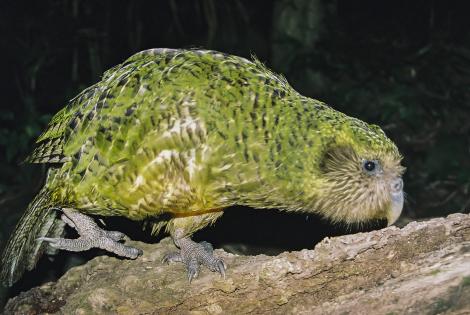
On an island off the coast of New Zealand, in the shadows of a primeval forest, an eerie sound resonates through the night. It's a deep boom that can sometimes be heard from miles away. This is the mating call of one of the strangest and most intriguing creatures in the region. Meet the critically endangered kākāpō.
Kākāpō (its name means “night parrot” in Māori) are large flightless parrots endemic to New Zealand. In 1894, conservationist Richard Henry relocated mainland birds to a supposedly safe island, but they were met by unsuspected predators. More kākāpō were found on the mainland and some surrounding islands in the 1970s. Though the mainland birds were later moved to those islands, only one survived. He was appropriately named Richard Henry.
The peculiar parrots now roam five islands free of predators, and their population has risen from a precarious 51 in 1995 to 252 in 2022. Still, the limited genetic diversity of such a small population has made breeding problematic. Breeding programs have found that most kākāpō are severely inbred and susceptible to disease and infertility. In an unprecedented move to conserve the species, researchers from the University of Otago have now sequenced the genome of nearly all existing birds in an effort to find out whether there are genetic variants in the population that could help keep the kākāpō from vanishing.
Be fruitful and multiply?
Once numerous on the mainland of New Zealand, kākāpō started to face new threats when humans arrived. The first Polynesian settlers hunted them for food and brought predatory dogs. Other predators, such as rats, possums, stoats, ferrets, and feral cats, were later brought by European settlers. The result: Very few birds remained, and there was a drastically limited gene pool.
Previous efforts at reviving the kākāpō population have involved genetic testing. The first individual genome was sequenced in 2016, but when it came to the genetic variants carried by other individuals, there were many unknowns. While sequencing one organism can tell us something about the genetic diversity of its species, conservation efforts benefit most when they can get genetic information from as many individuals as possible.
Sequencing an entire population can find where all most and least desirable genetic variants in the population are, helping scientists avoid mating birds that are too closely related or those that have too many detrimental variants.
The team involved in the new work was searching for variants associated with fertility and disease. Kākāpō have a dismal fertility record; many eggs never hatch, either due to infertility or embryo death. Further complicating reproductive issues is this parrot’s long life span, estimated at 80 to 100 years, with juveniles taking years to reach sexual maturity. They only breed every two to three years during the mass fruiting of plants like the rimu tree.
For these reasons, along with the breeding problems kakapo have in the wild because males outnumber females (who do not lay many eggs to begin with), scientists have relied on artificial insemination. Being able to select sperm from males that either have the most beneficial variants or are the most genetically compatible with certain females has been shown to reduce the problems associated with inbreeding. With a genetic layout of nearly the entire population, the Otago team is at even more of an advantage when it comes to which kākāpō genes should be combined.
“At a population level, [our method] can infer the number and effect size of genetic variants that contribute to differences between individuals,” they write in their new paper. “This genetic ‘architecture’ directly impacts small populations’ ability to adapt in response to selection.”
When the genes fit
Creating genetic diversity among the inbred kākāpō population was previously attempted by breeding individuals that were assumed to be unrelated, even when the precise degree of relation was unknown. Short, repeating segments of DNA known as microsatellites were used to test the relatedness of the parents. The problem is that microsatellites often give inaccurate estimates of which individuals are most and least related. Because kākāpō live so long, the genomes of almost all the birds that started the current population (including the now-deceased Richard Henry) were available to the researchers.
Analyzing the genomes of an entire population allowed the scientists to identify regions where specific variants were associated with a trait. Phenotypes such as growth rate and disease susceptibility were also factored into potential breeding decisions. Combining the individuals with promising genotypes and favorable phenotypes across the population gives kākāpō the best chance of continuing to produce viable offspring. This has resulted in birds being transferred to different islands to provide them with more genetically suitable mates.
The individual with the most genetic diversity proved to be Richard Henry, the only bird that had been transferred from the mainland and survived to breed. It's thought that this genetic diversity compared to the island kākāpō is due to the bird being from a mainland population. While there are mutations in the Richard Henry genome, many of those variants are unlikely to manifest because they are recessive, and they were also found to be outnumbered by variants that provide a greater chance for fertility and overall fitness of future offspring.
It's fitting that the kākāpō with the most valuable genes hails from Fiordland. The resurgence of the flightless parrot of the night once seemed like a fantasy, but genomic sequencing of nearly every existing one may be the way to not only restore their population but also make comebacks for other endangered species.
Nature Ecology and Evolution, 2023. DOI: 10.1038/s41559-023-02165-y



3175x175(CURRENT).thumb.jpg.b05acc060982b36f5891ba728e6d953c.jpg)
Recommended Comments
There are no comments to display.
Join the conversation
You can post now and register later. If you have an account, sign in now to post with your account.
Note: Your post will require moderator approval before it will be visible.